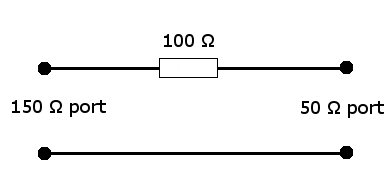CI Calibration: Difference between revisions
No edit summary |
|||
| Line 18: | Line 18: | ||
[[Image:150 ohm to 50 ohm adapter.jpg]] | [[Image:150 ohm to 50 ohm adapter.jpg]] | ||
The loss between the voltage on the 150 | The loss between the voltage on the 150 {{Ohm}} port to the 50 {{Ohm}} port is 9,5 dB. | ||
How do you calculate this? | How do you calculate this? | ||
| Line 24: | Line 24: | ||
The easiest way is by example. | The easiest way is by example. | ||
We assume that the voltage on the 150 | We assume that the voltage on the 150 {{Ohm}} port is 1 V, we chose this because this is 0 dBV and makes it easy to calculate. | ||
The voltage over the 50 | The voltage over the 50 {{Ohm}} port is 1 / 3 of the voltage of the 150 {{Ohm}} port. | ||
in formula: | in formula: | ||
| Line 38: | Line 38: | ||
so basically what every you are measuring with your 50 | so basically what every you are measuring with your 50 {{Ohm}} power sensor is 9,5 dB lower then the actual value. | ||
[[Category:RadiMation]] | [[Category:RadiMation]] | ||
[[Category:Calibration]] | [[Category:Calibration]] | ||
Revision as of 17:38, 12 January 2009
Tolerance[edit]
The tolerance in the CI calibration window gives you more control over the calibration. Let say you want to calibrate 10 mA (20 dbmA), with a tolerance of 0,5 dB This would mean that all generated levels between 10 mA and 10,59254 mA are accepted as correct values. The first thing you may wonder, why no fill in 0dB? This is possible, but will generate an large amount of warning because the desired levels can not be reached. 0 dB tolerance is only possible in an ideal world, and unfortunately our measuring equipment is not ideal. So what is the correct setting? this is depending on your needs, it is always a trade off between measuring speed and accuracy. When the desired level has been reached, this level is stored inside the calibration file. Meaning, if 10 watts is generating 11 mA, then 11 mA is stored together with the 10 watts. But if I do a substitution test? will it reproduce the 11 mA again if I set it to 10 mA? The answer is no, RadiMation will calculate power needed to achieve 10 mA and level to this. So in theory you can calibrate on 1 mA and perform testing at 100 mA, in practice you calibrate on 2 or 3 levels. for example 10 and 100 mA.
Insertion loss of the 150 to 50 Ω adapter[edit]
The loss between the voltage on the 150 Ω port to the 50 Ω port is 9,5 dB.
How do you calculate this?
The easiest way is by example.
We assume that the voltage on the 150 Ω port is 1 V, we chose this because this is 0 dBV and makes it easy to calculate.
The voltage over the 50 Ω port is 1 / 3 of the voltage of the 150 Ω port. in formula:
And 1/3 V is about -9,5 dBV
in formula:
so basically what every you are measuring with your 50 Ω power sensor is 9,5 dB lower then the actual value.


